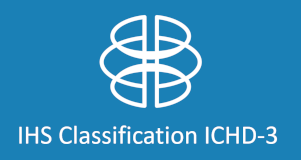1. MigraineHartmut Gobel2019-06-17T17:36:40+00:00
Coded elsewhere:
Migraine-like headache secondary to another disorder (symptomatic migraine) is coded as a secondary headache attributed to that disorder.
General comment
Primary or secondary headache or both?
Three rules apply to migraine-like headache, according to circumstances.
1. When a new headache with the characteristics of migraine occurs for the first time in close temporal relation to another disorder known to cause headache, or fulfils other criteria for causation by that disorder, the new headache is coded as a secondary headache attributed to the causative disorder.
2. When pre-existing migraine becomes chronic in close temporal relation to such a causative disorder, both the initial migraine diagnosis and the secondary diagnosis should be given. 8.2 Medication overuse headache is a particularly important example of this: both the migraine diagnosis (episodic or chronic) and the diagnosis 8.2 Medication overuse headache should be given when medication overuse is present.
3. When pre-existing migraine is made significantly worse (usually meaning a two-fold or greater increase in frequency and/or severity) in close temporal relation to such a causative disorder, both the initial migraine diagnosis and the secondary headache diagnosis should be given, provided that there is good evidence that the disorder can cause headache.
Introduction
Migraine is a common disabling primary headache disorder. Many epidemiological studies have documented its high prevalence and socio-economic and personal impacts. In the Global Burden of Disease Study2010 (GBD2010), it was ranked as the third most prevalent disorder in the world. In GBD2015, it was ranked third–highest cause of disability worldwide in both males and females under the age of 50 years.
Migraine has two major types. 1.1 Migraine without aura is a clinical syndrome characterized by headache with specific features and associated symptoms. 1.2 Migraine with aura is primarily characterized by the transient focal neurological symptoms that usually precede or sometimes accompany the headache. Some patients also experience a prodromalphase, occurring hours or days before the headache, and/or a postdromal phase following headache resolution. Prodromal and postdromalsymptoms include hyperactivity, hypoactivity, depression, cravings for particular foods, repetitive yawning, fatigue and neck stiffness and/orpain.
When a patient fulfils criteria for more than one type, subtype or subform of migraine, all should be diagnosed and coded. For example, a patient who has frequent attacks with aura but also some attacks without aura should be coded as 1.2 Migraine with aura and 1.1 Migraine without aura. However, since the diagnostic criteria for 1.3 Chronic migraine subsume attacks of all types, subtypes or subforms, additional coding is unnecessary for episodic subtypes of migraine.
